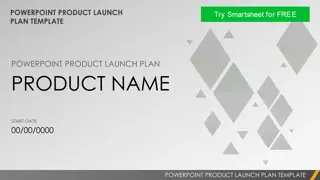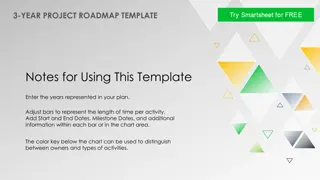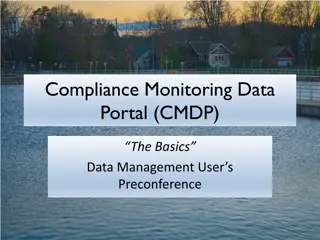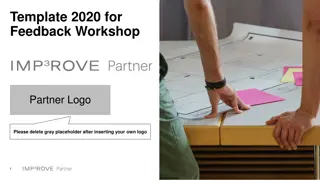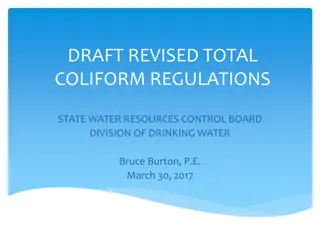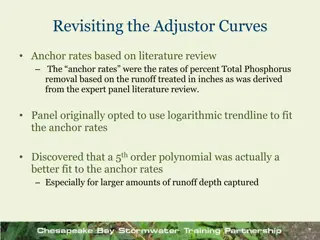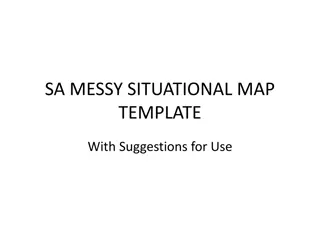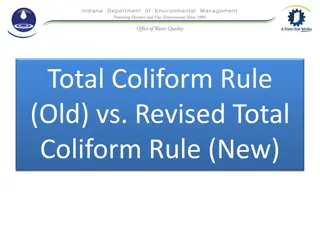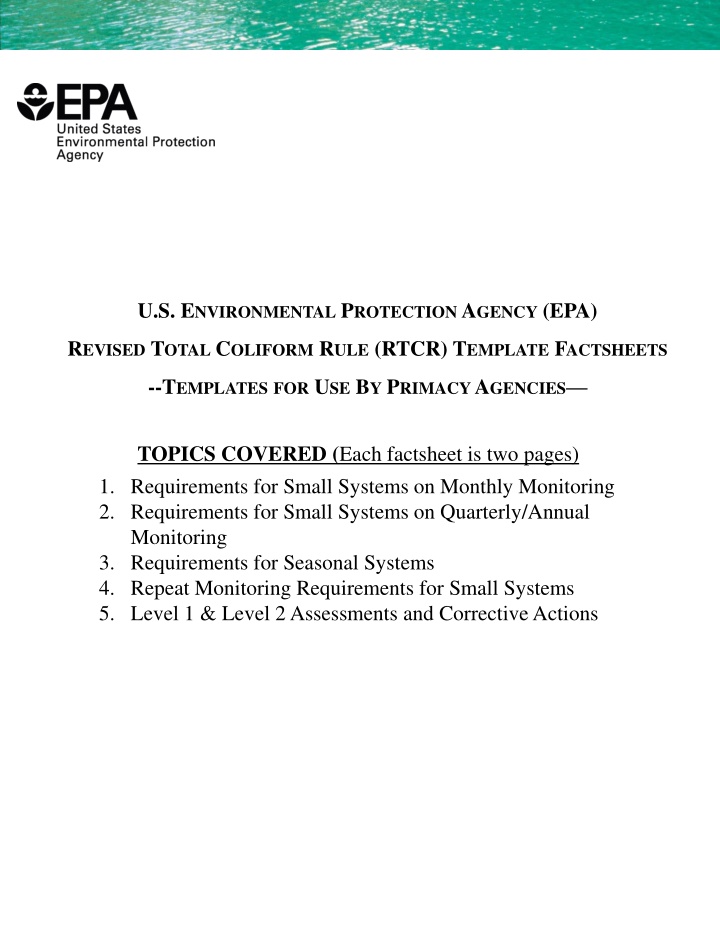
Revised Total Coliform Rule (RTCR) Factsheets for Small Water Systems
"Get insights into EPA's Revised Total Coliform Rule (RTCR) through template factsheets covering monitoring requirements for small, seasonal systems, repeat monitoring, and corrective actions. These factsheets offer guidance to states, tribes, and the U.S. Environmental Protection Agency (EPA) under the Safe Drinking Water Act (SDWA)."
Download Presentation

Please find below an Image/Link to download the presentation.
The content on the website is provided AS IS for your information and personal use only. It may not be sold, licensed, or shared on other websites without obtaining consent from the author. If you encounter any issues during the download, it is possible that the publisher has removed the file from their server.
You are allowed to download the files provided on this website for personal or commercial use, subject to the condition that they are used lawfully. All files are the property of their respective owners.
The content on the website is provided AS IS for your information and personal use only. It may not be sold, licensed, or shared on other websites without obtaining consent from the author.
E N D
Presentation Transcript
U.S. ENVIRONMENTAL PROTECTIONAGENCY (EPA) REVISED TOTAL COLIFORM RULE (RTCR) TEMPLATE FACTSHEETS --TEMPLATES FOR USE BY PRIMACYAGENCIES TOPICS COVERED (Each factsheet is two pages) 1. Requirements for Small Systems on Monthly Monitoring 2. Requirements for Small Systems on Quarterly/Annual Monitoring 3. Requirements for Seasonal Systems 4. Repeat Monitoring Requirements for Small Systems 5. Level 1 & Level 2 Assessments and Corrective Actions
Disclaimer Theses Template Factsheets provide guidance to states, tribes and the U.S. Environmental Protection Agency (EPA) exercising primary enforcement responsibility under the Safe Drinking Water Act (SDWA) and contains EPA s current policy recommendations for complying with the Revised Total Coliform Rule (RTCR). This document is not a regulation itself, nor does it change or substitute for those provisions and regulations. Thus, it does not impose legally binding requirements on EPA, states or the regulated community. This guidance does not confer legal rights or impose legal obligations upon any member of the public. While EPA has made every effort to ensure the accuracy of the discussion in this guidance, the obligations of the regulated community are determined by statutes, regulations or other legally binding requirements. In the event of a conflict between the discussion in this document and any statute or regulation, this document would not be controlling. Mention of trade names or commercial products does not constitute endorsement or recommendation for their use. This is a living document and may be revised periodically without public notice. EPA welcomes public input on this document at any time. Guidance provided in this document reflects provisions published on February 13, 2013, at 78 Federal Register 10269 and the minor corrections published on February 26, 2014, at 79 Federal Register 10665. Office of Water (MC-4606M) EPA 816-F-16-004 www.epa.gov/safewater May 2016
REVISED TOTALCOLIFORM RULE (RTCR) FACTSHEETS --TEMPLATES FOR PRIMACYAGENCIES PURPOSE: EPA has developed the attached five RTCR template factsheets for use by primacy agencies. Primacy agencies should use these factsheets when conducting RTCR training or outreach with small public water systems (PWSs) that serve 1,000 or fewer persons. As templates, these factsheets were designed to permit primacy agencies to change all parts and language as appropriate. TOPICS COVERED (Each factsheet is two pages) 1. Requirements for Small Systems on Monthly Monitoring 2. Requirements for Small Systems on Quarterly/Annual Monitoring 3. Requirements for Seasonal Systems 4. Repeat Monitoring Requirements for Small Systems 5. Level 1 & Level 2 Assessments and Corrective Actions INSTRUCTIONS NOTE: There are [placeholders] throughout the factsheets. Enter primacy agency specific information into these textbox placeholders, or delete the placeholders. For modifying text or graphics: There are two views in which changes can be made: (1) Normal: In this view, click into any [textbox] to edit text. Insert your state logo: Click in the center of the box in the upper left corner where it says, [ Click icon to add state logo ]. Browse to the location of the logo on your computer and Insert the image (e.g., jpg, png, gif). If part of your logo is cut off, click on Drawing Tools/Format/Crop and adjust the box so the whole image is viewable. Adjust the size as needed. Input state information into textbox = [ For assistance, Please Contact Your State] Input URL for the state drinking water program into textbox = [ For more information, visit our website at: ]. Located in the footer of the 2ndpage of each factsheet. Complete all [placeholders] with your primacy agency specific information: Throughout each factsheet there are placeholders. These placeholders are in square brackets (i.e., [ ]) and the font is colored for easy identification. (2) Slide master: Go into the slide master window to edit the top banner (e.g., image, top horizontal line, and text) and bottom banners. Each factsheet has its own slide master. Font types used are Tahoma for headers, Calibri for the body. and Century Gothic for the left sidebar. Font size used: no smaller than 12, except for the Seasonal Systems factsheet. For printing and distribution The factsheets are designed in MS PowerPoint. The design of the factsheets are to show on a computer screen from edge- to-edge. For best results, before printing, save the factsheet(s) as a PDF. To save as PDF: select File, select Save as PDF. If you do not convert to PDF, some of the text and diagrams may not be visible when printed. Select Print on Both Sides (Flip pages on long edge) and Shrink oversized pages from the print screen. If printing in black/white, print in [grayscale] for best results. If printing straight from MS PowerPoint, some text boxes and diagrams may not print in its entirety due to the oversize formatting. To fix, select Full Page Slides under the print layout from the print screen, and select Scale to Fit Paper. When sending electronically for mass distribution: Convert/save the file as a PDF before electronic distribution. If you do not convert, the recipient will be able to make changes to the factsheet.
(RTCR) FACTSHEET: Revised Total Coliform Rule Requirements for Small Systems on Monthly Monitoring WHO DOESTHIS FACTSHEET APPLY TO? ALLPUBLICWATERSYSTEMS (PWSS), REGARDLESSOFSOURCE, THATSERVE 1,000 PEOPLEORFEWERand collect at least one routine total coliform (TC) SAMPLEMONTHLY. RTCR What to Do? ATTENTION! All PWSs must comply with the RTCR requirements starting April 1, 2016. Are you a PWS? Contact your state at [Placeholder for state info/website]. Step 1 Develop/update your sample siting plan. Step 2 Collect your drinking water samples. Step 3 Conduct required actions. STEP 1: DEVELOP/UPDATE YOUR SAMPLE SITING PLAN* Contact your state for assistance. DEVELOPASAMPLESITINGPLANANDHAVEITREADYFORUSEBY APRIL 1, 2016. If you already have a sample siting plan for the Total Coliform Rule (TCR), update this plan to meet the requirements of the RTCR. LISTTHELOCATIONSWHEREYOUWILLTAKEYOURSAMPLES (ROUTINEANDREPEAT): Any repeat sampling location that is also used for GWR triggered source water monitoring must be included. INCLUDEYOURROUTINECOLLECTIONSCHEDULE: For example, [PWS_ID] will collect one routine total coliform sample every first Monday of the calendar month. UPDATETOREFLECTCHANGESATYOUR PWS: The sample siting plan is a living document and should be updated to reflect changes at your PWS such as: major changes in population; a new or additional water source; infrastructure changes, such as a change in the distribution system (i.e. extended/abandoned lines) or pressure zones; or changes in disinfection or other treatment. Additional RTCR Factsheets: Requirements for Small Systems on Quarterly/ Annual Monitoring Requirements for Seasonal Systems Repeat Monitoring Requirements for Small Systems Level 1 & Level 2 Assessments and Corrective Actions STEP 2: COLLECT YOUR DRINKING WATER SAMPLES Know your RTCR routine sampling requirements. COLLECTATLEASTONE 100 MLroutine drinking water sample every calendar month. IMMEDIATELYSENDYOURSAMPLETOASTATE-CERTIFIEDLABthat performs total coliform drinking water analyses. Remember the lab must begin analyzing the drinking water sample no later than the 30th hour from the collection time. If necessary, ship the sample overnight and refrigerate or ice the sample using blue ice (cooled to about 4 to 10 C). FORASSISTANCE, PLEASE CONTACTYOURSTATE: NAME/DEPT.: PHONE: NOTE * The sample siting plan is subject to review and revision by [State name/drinking water program office]. EMAIL:
RTCR STEP 3: CONDUCT ACTIONS REQUIRED ASA RESULTOF YOUR SAMPLING Was your routine sample total coliform-positive (TC+)? YES NO Continue with routine monitoring schedule, according to your sample siting plan. For each TC+ sample, do the following TWO ACTIONS: 1. Make sure the lab tests each TC+ sample for E. coli; AND If any repeat sample is TC+ (or TC is present): Call your state immediately and tell them you triggered an assessment. The state will help you identify which type of assessment is required. 2. Within 24 hours of being notified of the TC+ sample, take 3 repeat samples; * See the RTCR Factsheet: Repeat Monitoring Requirements for Small Systems. See the RTCR Factsheet: Level 1 & 2 Assessments and Corrective Actions. NOTE: You may have to comply with other requirements triggered by a TC+ sample (e.g. Public Notification, Recordkeeping). Were any of the samples E. coli- positive (EC+)? NO Contact your state for more information. YES** Call your state!You have to perform a Level 2 Assessment if the PWS has any of the following occurrences: TC+ Routine and EC+ Repeat sample; EC+ Routine and TC+ Repeat sample; The PWS fails to take and analyze all 3 required repeat samples following an EC+ routine sample; or, The PWS fails to test for E. coli when any repeat sample is TC+. Within 30 days after you learned your PWS has triggered an assessment, a completed assessment form must be submitted to the state. Download the state form at [Placeholder for state URL info]. See the RTCR Factsheet: Level 1 & 2 Assessments and Corrective Actions. NOTES * If you are missing any routine or repeat sample, contact your state. ** Call your state on the same day you learn of the EC+ result, or by the end of the next business day or [Placeholder for state after-hours phone line or an alternative notification procedure] and tell them you received an EC+ result. For more information, visit our website at: [Placeholder for state URL info] March 2016
(RTCR) FACTSHEET: Revised Total Coliform Rule Requirements for Small Systems on Quarterly/Annual Monitoring WHO DOESTHIS FACTSHEET APPLY TO? GROUNDWATERPUBLICWATERSYSTEMS (PWSS) THATSERVE 1,000 ORFEWERPEOPLEand collect at least one routine total coliform (TC) SAMPLEQUARTERLYORANNUALLY. ATTENTION! RTCR What to Do? All PWSs must comply with the RTCR requirements starting April 1, 2016. Are you a PWS? Contact your state at [Placeholder for state info/website]. Step 1 Develop/update your sample siting plan. STEP 1: DEVELOP/UPDATE YOUR SAMPLE SITING PLAN* CONTACTYOURSTATEFORASSISTANCE. DEVELOPASAMPLESITINGPLANANDHAVEITREADYFORUSEBY APRIL 1, 2016. If you already have a sample siting plan in use for the Total Coliform Rule (TCR), update this plan to meet the requirements of the RTCR. LISTTHELOCATIONSWHEREYOUWILLTAKEYOURSAMPLES (ROUTINEANDREPEAT): Any repeat sampling location that is also used for GWR triggered source water monitoring must be included. INCLUDEYOURROUTINECOLLECTIONSCHEDULE: for example, the first Monday of every calendar quarter between Jan. 1 March 31, April 1 June 30, July 1 Sept. 30, and Oct. 1 Dec. 31; or every calendar year from Jan. 1 Dec. 31. UPDATETOREFLECTCHANGESATYOUR PWS: The sample siting plan is a living document and should be updated to reflect changes at your PWS such as: major changes in population; a new or additional water source; infrastructure changes, such as a change in the distribution system (i.e. extended/abandoned lines) or pressure zones; or, changes in disinfection or other treatment. STEP 2: COLLECT YOUR DRINKING WATER SAMPLES KNOWYOUR RTCR ROUTINESAMPLINGREQUIREMENTS. Step 2 Collect your drinking water samples. Step 3 Conduct required actions. Additional RTCR Factsheets: Requirements for Small Systems on Monthly Monitoring Requirements for Seasonal Systems Repeat Monitoring Requirements for Small Systems Level 1 & Level 2 Assessments and Corrective Actions COLLECTATLEASTONE 100 MLroutine drinking water sample every quarter or once per year depending on whether you are on a quarterly or annual monitoring schedule, starting April 1, 2016. IMMEDIATELYSENDYOURSAMPLETOASTATE-CERTIFIEDLABthat performs total coliform drinking water analysis. Remember the lab must begin analyzing the drinking water sample no later than the 30th hour from the collection time. If necessary, ship the sample overnight and refrigerate or ice the sample using blue ice (cooled to about 4 to 10 C). FORASSISTANCE, PLEASE CONTACTYOURSTATE: NAME/DEPT.: PHONE: NOTE * The sample siting plan is subject to review and revisions by [State name/drinking water program office]. EMAIL:
RTCR STEP 3: CONDUCT ACTIONS REQUIRED ASA RESULTOF YOUR SAMPLING Was your routine sample total coliform-positive (TC+)? ** YES NO Continue with routine monitoring schedule, according to your sample siting plan. For each TC+ routine sample, do the following THREE ACTIONS: 1. Make sure the lab tests each TC+ sample for E. coli; AND If any repeat sample is TC+ (or present for TC), call your state immediately and tell them you triggered an assessment. The state will help you identify which type of assessment is required. 2. Collect 3 repeat samples for each TC+ routine sample.* See RTCR Factsheet: Repeat Monitoring Requirements for Small Systems; AND 3. Take 3 additional routine samples the following month at your routine sample location(s). Collect at regular time intervals throughout the month or on a single day if taken from different sites. * See the RTCR Factsheet: Level 1 & 2 Assessments and Corrective Actions. NOTE: You may have to comply with other requirements triggered by a TC+ sample (e.g., public Notification, Record Keeping). Were any of the samples E. coli- positive (EC+)? NO YES** Call your state!You have to perform a Level 2 Assessment if the PWS has any of the following occurrences: TC+ Routine and EC+ Repeat sample; EC+ Routine and TC+ Repeat sample; The PWS fails to take all 3 required repeat samples following an EC+ routine sample; or, The PWS fails to test for E. coli when any repeat sample is TC+. Within 30 days after you learned your PWS has triggered an assessment, a completed assessment form must be submitted to the state. Download the state form at [Placeholder for state website]. See the RTCR Factsheet: Level 1 & 2 Assessments and Corrective Actions. NOTES *If you are missing any routine, repeat, or additional routine samples, contact your state. **Call your state on the same day you learn of the EC+ result, or by the end of the next business day, or [Placeholder for state after-hours phone line or an alternative notification procedure] and tell them you received an EC+ result. For more information, visit our website at: [Placeholder for state URL info] March 2016
(RTCR) FACTSHEET: Revised Total Coliform Rule Requirements for Seasonal Systems WHO DOESTHIS FACTSHEET APPLYTO? SEASONALSYSTEMS A seasonal system is defined as a non-community water system that is not operated as a public water system (PWS) on a year-round basis and starts-up and shuts-down at the beginning and end of each operating season. Examples include campgrounds, fairgrounds, seasonal food service facilities, and ski areas. ATTENTION! RTCR What to Do? STARTING APRIL 1, 2016, all seasonal systems must complete the state required startup procedures before serving water to the public. Your water system must complete and submit the state certification form confirming completion of these start-up procedures. Step 1 Conduct start-up procedures Step 2 Complete certification forms Step 3 Maintain good water quality Step 4 Complete shutdown procedures STEP 1: CONDUCT START-UP PROCEDURES You must conduct your state start-up procedures before delivering drinking water to your customers. Start-up procedures help reduce the presence of harmful bacteria in water. The checklist is available on our website at [Website placeholder]. FLUSHALLPIPESUNTILTHEWATERISCLEAR Flushing the pipe lines in all areas of your water system helps remove buildup and dirty water that has gathered during the off season. Flushing the pipes helps the disinfectant work more effectively to kill bacteria and inactivate viruses. CLEANALLWATERSTORAGETANKS Drain and clean the tanks before delivering water to your customers. Harmful sediments may build up over time inside and along the walls of the water tanks. It is recommended that the tank be inspected and cleaned regularly. Contact the state for information about proper procedures for inspecting a tank. DISINFECT Kill harmful bacteria and inactivate viruses by adding a disinfectant or by making sure the adequate disinfectant residual is present in all areas of your water pipes. Your system should be flushed thoroughly. Be sure to keep the highly chlorinated water away from surface water bodies such as lakes, streams, and ponds, as well as septic systems. Remember, you may not deliver water to your customers until proper disinfecting and flushing of your system is completed. Check our website [Website placeholder] or call the state to get more information about how to disinfect your water system. INSPECTAND REPAIR Consider having a qualified water system professional inspect and repair your water system before you deliver water to your customers. Some parts of your water system may have broken down or become worn out during the off season. This can create a situation where bacteria can enter the drinking water. You can find a list of state certified water system professionals to help with finding any defects at your water system at this website: [Website placeholder]. Additional RTCR Factsheets: Requirements for Small Systems on Monthly Monitoring Requirements for Small Systems on Quarterly/ Annual Monitoring Repeat Monitoring Requirements for Small Systems Level 1 & Level 2 Assessments and Corrective Actions COLLECT SAMPLES Collect water samples and have them tested for the presence of bacteria and chlorine residuals at a state certified lab, after flushing, cleaning, disinfecting, and repairing your water system. Also, sample and test to determine if the adequate amount of disinfectant residual is present to help provide safer drinking water. You should find out your sample results before delivering water to your customers. Check our website [Website placeholder] or call the state to get more information about disinfectant residual levels.
RTCR STEP 2: COMPLETE CERTIFICATION FORMS EACHYEARBEFOREDELIVERING WATERTOYOURCUSTOMERS [State Drinking Water Contact Name] CONTACTYOURSTATEif you need help understanding or following the Start-Up Procedures. [Department] [Street Address] PERFORM the items in the start-up procedures checklist. The checklist is available on our website at [Website placeholder]. [City] COMPLETE the Start-Up Procedures Certification Form. The form is available on our website at [Website placeholder]. [State] [Postal code] SUBMITStart-Up Procedures Certification Form to the state. WHENYOUSIGNANDSUBMITthis form, you are certifying that you have completed all of the start-up procedures, including: Flushed all pipes. Cleaned all water storage tanks (if applicable). Disinfected entire water system. Inspected water system. Repaired water system (if applicable). Collected samples to test for bacteria and disinfectant residual. STEP 3: MAINTAINGOODWATERQUALITYANDAGOODREPUTATIONWITHYOUR CUSTOMERS If your water system does not complete all of the start-up procedures, you must notify your customers that your water system had a drinking water violation for failure to complete start-up procedures and tell them of any possible health risks. CONTACTYOURSTATEfor information on the proper public notification procedures (including language you must use), and timing. STEP 4: COMPLETE SHUTDOWN PROCEDURES Similar to start-up procedures, completing shutdown procedures at the end of your business season will help you minimize repairs to the water system when your water system opens up again next season. To determine appropriate shutdown procedures for your water system, contact your state. In general, you should: Inspect your entire system and look for problems and damage that need attention or repairs. Turn off the power to your water supply pump and all treatment systems. If there is potential for your pressure tank or storage tank to freeze, drain it. If there is no potential for your tanks to freeze, you may choose to leave them full. Drain all of the water from your internal plumbing. Protect your distribution system by not leaving taps open in the off season. March 2016 For more information, visit our website at: [Placeholder for state URL info]
(RTCR) FACTSHEET: Revised Total Coliform Rule Repeat Monitoring Requirements For Small Systems WHODOESTHIS FACTSHEET APPLYTO? ALL PUBLICWATERSYSTEMS (PWSS) SERVING 1,000 ORFEWERPEOPLEthat are required to conduct repeat monitoring when a water sample is POSITIVEFORTOTALCOLIFORM (TC+) BACTERIA. ATTENTION! RTCR What to Do? April 1, 2016, all public water systems (PWSs) must comply with the RTCR. Are you a PWS? Contact your state at [Placeholder for state info/website]. STEP 1: COLLECT 3 REPEATSAMPLESFOREACH ROUTINE TC+ SAMPLE Step 1 Collect 3 repeat samples after each TC+ routine sample YOUMUSTCOLLECTASETOF 3 REPEATSAMPLESAFTEREACH TC+ ROUTINESAMPLE. You must continue to collect a set of 3 repeat samples until either TC is not detected in one complete set of repeat samples or you trigger an assessment. Repeat Sampling Locations You must collect at least 3 repeat samples at the locations described in your sample siting plan: (1) 1 repeat sample at the original routine location, (2) 1 repeat sample within five service connections upstream, and (3) 1 repeat sample within five service connections downstream of the TC+ sample. You may choose alternative repeat sampling locations on a situational basis contact your state for more information. Step 2 Conduct required actions after collecting repeat samples ATTENTION! 2 COLLECTALL 3 REPEATSAMPLES. If you do not collect and analyze at least 3 repeat samples (for each routine TC+) you will have to perform a Level 1 or Level 2 assessment. See the RTCR Factsheet: Level 1 & Level 2 Assessments and Corrective Actions. 1 3 Site B = 1 repeat upstream Additional RTCR Factsheets: Requirements for Small Systems on Monthly Monitoring Requirements for Small Systems on Quarterly/ Annual Monitoring Requirements for Seasonal Systems Level 1 & Level 2 Assessments and Corrective Actions Site A = 1 repeat Original routine location that tested TC+ Site C = 1 repeat downstream Frequency & Timing REMINDER: ANALYZEALLREPEAT TC+ SAMPLESFORE. COLI.* Collect all 3 repeat samples WITHIN 24 HOURS**AFTERRECEIVINGNOTIFICATIONFROM THESTATE-CERTIFIEDLABOFTHE TC+ SAMPLERESULT. The repeat samples must be taken on the same day. Remember the lab must begin analyzing the drinking water sample no later than the 30th hour from the collection time. If necessary, ship the sample overnight and refrigerate or ice the sample using blue ice (cooled to about 4 to 10 C). FORASSISTANCE, PLEASECONTACT YOURSTATE: NOTES *CALL YOUR STATE on the same day you learned of the E. coli-positive (EC+) result, or by the end of the next business day if the result came in after business hours [Placeholder for state after-hours phone line or an alternative notification procedure] and tell them you received an EC+ result. **Contact your state for an approved extension if logistical problems prevent collection within 24 hours. NAME/DEPT.: PHONE: EMAIL:
RTCR STEP 2: CONDUCT ACTIONS REQUIRED ASA RESULTOF YOUR REPEAT SAMPLING TC+ = Total coliform-positive or present; TC- =Total coliform-negative or absent EC+ = E. coli-positive or present; EC- = E. coli-negative or absent; EC? = E. coli not analyzed You must COMPLETEANASSESSMENTANDSUBMITTHEFORMTOTHESTATEWITHIN 30 DAYSafter you learned your PWS has triggered an assessment. See the RTCR Factsheet: Level 1 & Level 2 Assessments and Corrective Actions. If Routine Sample Is: Any Repeat Sample Is: And Action: What do your sample results mean? Violation The presence of total coliform bacteria in both your original routine sample and in your follow-up repeat sample suggests there could be a problem and your water may not be safe to use. 1. CONDUCTA LEVEL 1 OR LEVEL 2 ASSESSMENT. Contact the state for help determining which type of assessment is required. TC+ EC- TC+ EC- No MCL violation & The presence of total coliform bacteria in both your original routine sample and in your follow-up repeat sample suggests there could be a problem and because E. coli was not tested, it is unknown whether or not the water is safe to use. 1. NOTIFYTHESTATEwithin 24 hours of receiving sample results 2. CONDUCTA LEVEL 2 ASSESSMENT. 3. ISSUEA PUBLIC NOTICE (PN). TC+ EC- TC+ EC? E. coli MCL violation* & The presence of E. coli bacteria in your water is an indicator of fecal contamination and your water may not be safe to use. 1. NOTIFYTHESTATEwithin 24 hours of receiving sample results 2. CONDUCTA LEVEL 2 ASSESSMENT. 3. ISSUEA PUBLIC NOTICE (PN). TC+ EC- TC+ EC+ E. coli MCL violation* & The presence of total coliform bacteria in your original routine sample suggests there could be a problem and because repeat samples were not tested, it is unknown whether or not the water is safe to use. 1. CONDUCTA LEVEL 1 OR LEVEL 2 ASSESSMENT. Contact the state for help determining which type of assessment is required. TC+ EC- Any or all repeat samples missing No MCL violation & The presence of E. coli bacteria in your water is an indicator of fecal contamination and your water may not be safe to use. 1. NOTIFYTHESTATEwithin 24 hours of receiving sample results 2. CONDUCTA LEVEL 2 ASSESSMENT. 3. ISSUEA PUBLIC NOTICE (PN). TC+ EC+ E. coli MCL violation* & TC+ The presence of E. coli bacteria in your water is an indicator of fecal contamination and your water may not be safe to use. 1. NOTIFYTHESTATEwithin 24 hours of receiving sample results 2. CONDUCTA LEVEL 2 ASSESSMENT. 3. ISSUEA PUBLIC NOTICE (PN). TC+ EC+ Any or all repeat samples missing E. coli MCL violation* & NOTE * You are required to provide Tier 1 public notice within 24 hours in response to an E. coli MCL violation. March 2016 For more information, visit our website at: [Placeholder for state URL info]
(RTCR) FACTSHEET: Revised Total Coliform Rule Level 1 & Level 2 Assessments and Corrective Actions WHODOESTHIS FACTSHEET APPLYTO? PUBLICWATERSYSTEMS (PWSS) SERVING 1,000 ORFEWERPEOPLEthat must conduct a Level 1 or Level 2 assessment. ATTENTION! RTCR April 1, 2016, all public water systems (PWSs) must comply with the RTCR. Are you a PWS? Contact your state at [Placeholder for state info/website]. What to know? What is an Assessment? Throughout the Assessment Process. What to do if you are triggered to conduct an assessment. WHATISAN ASSESSMENT? When sampling results show that your PWS may be vulnerable to contamination, PWSs must perform an assessment (Level 1 or Level 2) and FINDANDFIXANY SANITARYDEFECTS. A sanitary defect can provide a pathway of entry for microbial contamination into the distribution system or indicate imminent failure in an existing barrier (e.g. cracked tank, rat droppings on wellheads, or broken seals). THEREARE 5 BASICELEMENTSTOINVESTIGATEDURINGANASSESSMENT: Atypical events that may affect distributed water quality or indicate that distributed water quality was impaired; Changes in distribution system maintenance and operation, including water storage; Water source and treatment methods that affect distributed water quality; Inadequacies in sample sites, sampling protocol and sample processing; and Existing water quality monitoring data. Additional RTCR Factsheets: Requirements for Small Systems on Monthly Monitoring Requirements for Small Systems on Quarterly/Annual Monitoring Requirements for Seasonal Systems Repeat Monitoring Requirements for Small Systems A LEVEL 2 ASSESSMENTISAMORECOMPREHENSIVEANDIN-DEPTHEXAMINATIONCOMPAREDTO ALEVEL 1 ASSESSMENTbecause the cause of the Level 2 assessment is more critical and likely to result in a direct public health impact. A Level 2 assessment must be conducted by the state or a party approved by the state. A Level 1 assessment is typically conducted by the PWS. You have 30 days (after learning that you triggered the assessment) to complete, correct sanitary defects found, and submit the State-form. For sanitary defects found but NOT fixed within the 30 days, you must obtain a state-approved schedule for all incomplete corrective actions. AFTERCOMPLETINGEACHSCHEDULED CORRECTIVEACTION,YOUMUSTNOTIFYYOURSTATETOAVOIDVIOLATIONS. Throughout the Assessment Process CONSULTWITHYOURSTATEto discuss progress. Examples of Common Causes of Contamination Example Common Corrective Action(s) Maintenance of adequate pressure Valve maintenance Addition or upgrade of on-line monitoring & control Maintenance of adequate pressure Installation of backflow prevention assembly/device Implementation/upgrade of cross connection control program Replacement/repair of well components FORASSISTANCE, PLEASE CONTACTYOURSTATE: Loss of system pressure NAME/DEPT.: Cross connections PHONE: EMAIL: Cracks in well seal, casing, etc.
RTCR WHATTODOIFYOUTRIGGEREDANASSESSMENT? WITHIN 30 DAYSOFLEARNINGTHATYOUR PWS TRIGGEREDANASSESSMENT, a completed state assessment form must be submitted to your state. The process for completing and submitting the required form depends on the type of assessment. In both cases, your state will review the completed assessment form to determine if the likely cause of the trigger has been identified and to ensure the problem is corrected. Level Assessment Level Assessment You have to do a Level 1 Assessment if you: You have to do a Level 2 Assessment if you have either: 1. E. coli MCL violation: 1. Fail to collect and analyze at least 3 repeat samples for each routine TC+; or Routine Repeat TC+ & EC- E. coli-positive (EC+) 2. Have two or more TC+ samples (use routine and repeat results in your calculation) in one month. TC+ & EC- TC+ but not analyzed for EC TC+ & EC+ TC+ TC+ & EC+ One or more samples is missing TC+TC+ 2. Two Level 1 triggers in a rolling 12-month period or for systems on annual monitoring, a Level 1 trigger in two consecutive years. Your state approves the party that will conduct the assessment. Your system conducts the assessment. STEP 1: Call your state to select the appropriate person to conduct the assessment (the assessor). Assessors may be the state, a third party or qualified staff from your system. STEP 1: Call your state, and verify the appropriate person to conduct the assessment (the assessor). STEP 2: Ask the state for the Level 1 assessment form and determine the process for submission. STEP 2: Ask the state for the Level 2 assessment form and determine the process for submission. STEP 3: Perform the assessment. STEP 3: Have the assessment performed. STEP 4: If sanitary defect(s) are found, fix them or propose and gain a state-approved schedule for fixing, if the sanitary defect(s) cannot be corrected within 30 days of triggering the assessment. After completing each scheduled corrective action you must notify your state. The PWS or state (at any time) may consult with each other to discuss progress or the corrective action(s) identified. STEP 4: If sanitary defect(s) are found, fix them or propose and gain a state-approved schedule for fixing, if the sanitary defect(s) cannot be corrected within 30 days of triggering the assessment. After completing each scheduled corrective action you must notify your state. The PWS or state (at any time) may consult with each other to discuss progress or the corrective action(s) identified. STEP 5: Submit the completed assessment form to the state within 30 days of learning that your system triggered the assessment. STEP 5: Submit the completed assessment form to the state within 30 days of learning that your system triggered the assessment. NOTES Your PWS will get a treatment technique violation if you: Fail to perform an assessment or take corrective action. You are required to provide Tier 2 public notice within 30 days in response to a treatment technique violation. March 2016 For more information, visit our website at: [Placeholder for state URL info]






